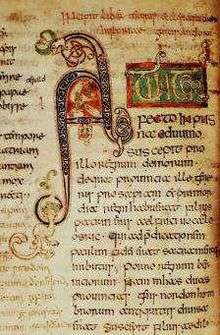Tiberius Bede
British Library, MS Cotton Tiberius C. II, or the Tiberius Bede, is an 8th-century illuminated manuscript of Bede's Historia ecclesiastica gentis Anglorum. It is one of only four surviving 8th-century manuscripts of Bede, another of which happens to be MS Cotton Tiberius A. XIV, produced at Monkwearmouth–Jarrow Abbey.[1] As such it is one of the closest texts to Bede's autograph. The manuscript has 155 vellum folios. This manuscript may have been the Latin text on which the Alfredian Old English translation of Bede's Ecclesiastical History was based. The manuscript is decorated with zoomorphic initials in a partly Insular and partly Continental style.

The manuscript has given its name to the 'Tiberius' group of manuscripts, connected on stylistic grounds and sometimes also known as the 'Canterbury' group, though the region of their production remains unknown – Mercia has also been suggested. Apart from the Tiberius Bede, the group includes: Vespasian Psalter, Stockholm Codex Aureus, Barberini Gospels, Book of Cerne,[2] Blickling Psalter, Codex Bigotianus (BnF MS lat. 281, 298),[3] Royal Bible (British Library MS Royal 1.E.vi),[4] Royal Prayerbook, Book of Nunnaminster,[5] Harleian Prayerbook,[6] Saint Petersburg Gospels,[7] Anglian collection manuscript V (British Library MS Cotton Vespasian B.vi, folios 104–109),[2][8][9] BnF MS lat. 10861,[6][10] Bodleian Library MS Hatton 93, Salisbury Cathedral Library MS 117,[2][11] and a number of other manuscripts.[2][12]
Notes
- British Library
- Brown 2005, p. 282
- Brown 2011, p. 134
- Brown 2011, p. 139
- Brown 2011, p. 158
- Brown 2011, p. 162
- Brown 2005, pp. 282–283
- Brown 2011, p. 164
- Dumville 1976
- Brown 1986
- Brown 2011, pp. 163–164
- Brown 2011, p. 164 n. 213
References
- Michelle P. Brown (1986). "Paris, Bibliothèque Nationale, lat. 10861 and the scriptorium of Christ Church, Canterbury". Anglo-Saxon England. 15: 119–137. doi:10.1017/S0263675100003720.
- relevant plates (I–IV) are available online at the end of another article in the same volume of the journal, doi:10.1017/S026367510000209X
- Michelle P. Brown (2005). "Mercian manuscripts? The "Tiberius" group and its historical context". In Michelle P. Brown; Carol A. Farr (eds.). Mercia: An Anglo-Saxon Kingdom in Europe. pp. 281–291. ISBN 978-1-4411-5353-1. google books preview
- Michelle P. Brown (2011). "Writing in the Insular world". In Richard Gameson (ed.). The Cambridge History of the Book in Britain Volume 1: c.400–1100. Cambridge University Press. pp. 121–166. doi:10.1017/CHOL9780521583459.005. ISBN 978-0-521-58345-9.
- David N. Dumville (1976). "The Anglian collection of royal genealogies and regnal lists". Anglo-Saxon England. 5: 23–50. doi:10.1017/S0263675100000764.